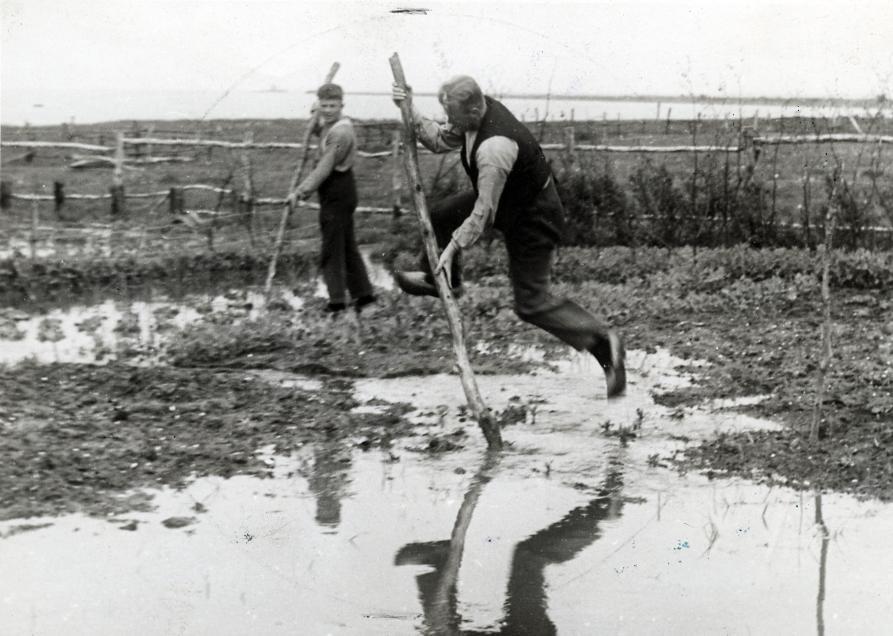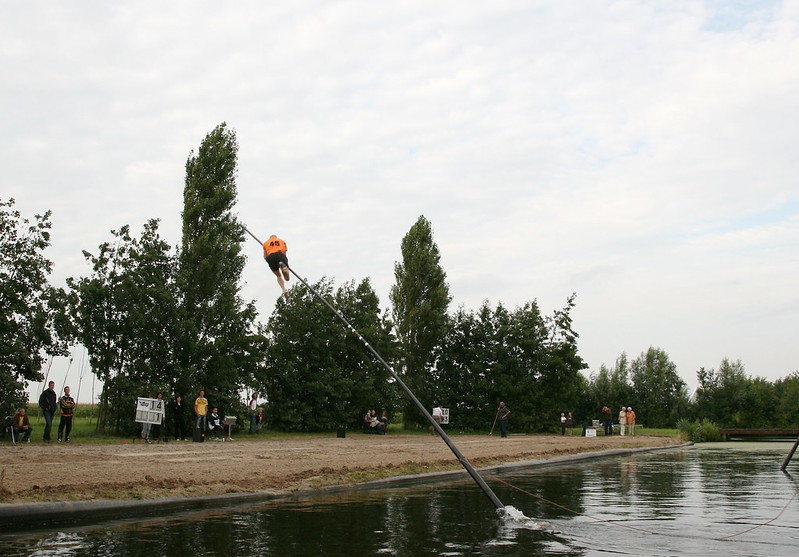What has a giant stick, superior upper body strength, and can cross a canal in a single bound? A fierljepper, of course! But what are these curious flying Dutchmen? How exactly do you fierljep? And how on earth do you pronounce that word?
This athletically demanding sport hails from West Frisia, Friesland but has spread all over the Netherlands, next door to Germany and even to other continents.
Sit back, grab a pole and relax: we’ve got everything you need to know about the curious Dutch sport fierljeppen.
How do you pronounce it?
There are a lot of letters in that word, so let’s break it down before you flip-flop all over your mouth, which sounds uncomfortable for you and awkward for us.
Fier-ljep-pen. Or, phonetically fier-lep-en. Or, just press play on the below:
What is fierljeppen?
This strange combination of vowels and consonants is a sport that resembles pole-vaulting — in the most Dutch way possible, of course. Directly translated from Frisian, fierljeppen means “far leap.”
The goal of fierljeppen is to get as far as possible from the starting point while crossing a canal. Easy, right? Well, not really.
Where did this sport come from?
Fierljeppen is a sport that was born out of necessity — the need to get over the various canals that crisscross the Netherlands.
Farmers began the practice when they decided that instead of going around the water, they would go over it. Genius!

There are written records of fierljeppen dating all the way back to the 1200s, and paintings of people fierljepp-ing their way across the fields.
Always a competitive bunch, the Dutch hosted the first fierljeppen competition in 1767.
READ MORE |11 Dutch sports that are 100% weird (but wonderful)
Bridges and roads being built in the Netherlands reduced the need for fierljeppen as a method of transport.
But launching yourself through the air at the mercy of a stick is pretty fun, right? So the Dutch turned it into a competitive sport in 1975.
How do you fierljep?
To begin, a fierljepper sprints like mad 15-20 metres towards a canal.
When they reach the canal, they grab hold of a large pole (polsstok) and push it into the bottom of the muddy water.
Relying on brute gravity and force, the fierljepper then rapidly climbs and attempts to control the pole midair as it begins to swing to the opposite side.
If successful, the fierljepper lands gracefully on the other side of the canal on a soft bed of sand. If unsuccessful, well… 🤷
The pole that the competitor grabs onto is strategically positioned prior to the jump.
A pole that is closer to the finishing end will get a competitor further, and give them more time to climb, but requires more momentum to make it all the way across.
If the pole is placed closer to the starting position, it requires less momentum — but gives the competitor less time to climb, resulting in a shorter distance achieved.
While the goal of fierljeppen is to go straight forward, some competitors fall backwards, and others fall sideways into the canal.
READ MORE | The time Dutch people made headwind cycling into a competition — and it’s absolutely hilarious
This is common even at the highest levels because fierljeppers will try to pass the dead centre (pole sticking straight up) as slowly as possible to maximize their climbing time.
What is a fierljeppen pole?
When it comes to fierljeppen, not just any pole will do. A polsstok (jumping pole) has a round, flat base to prevent it from sinking into the muddy bottom of the canal.
In the past, the poles were made of wood, then later constructed from aluminium. Today, the poles are made of lightweight carbon fibre.
While we all know size doesn’t matter, that’s not true for this sport: the size of the pole ranges in size from eight to 13 metres. More length = more height = more distance = more winning! 🏆
How do you win?
In fierljeppen, the only thing that matters is where a fierljepper lands. When a competitor clears the canal and lands on the bed of sand, the distance is the only thing that affects the score.
A competitor that climbed their pole halfway could technically still win over another competitor who climbed theirs all the way to the top, as long as they landed a further distance away.
You almost always have a friend in fierljeppen
Some competition rules state that when a competitor takes off on their sprint towards the pole, they have another person running directly behind them — a spotter.
If the pole begins falling backwards (as in the direction that the competitor was running from), the spotter can yell “let go!” and stop the competitor from taking a nasty fall. It can also be motivating to have someone chasing you on your sprint.
There are cases where the spotter has been a little too focussed on spotting and less focused on watching where they were going — leading to the spotter tumbling into the water below. Oops. 😅
Fierljeppen records
So how far is a far leap?
When fierljeppen began, these leapers would jump around 10 metres. Thanks to a better understanding of the sport and changes in pole material, the world record distance for fierljeppen is now 22.21 metres, held by Jaco de Groot from Utrecht.
Not bad for a run, climb, and jump!
| Category | Name | Distance (metres) | Place | Date |
| Seniors | Jaco de Groot | 22.21 | Zegveld | 12-08-2017 |
| Ladies | Marrit van der Wal | 18.19 | Burgum | 31-07-2019 |
| Juniors | Reinier Overbeek | 21.38 | Burgum | 19-08-2019 |
| Veterans | Theo van Kooten | 20.60 | Linschoten | 31-07-2013 |
Source: Nederlands Fierljepbond
Where can you fierljep?
Today there are over 600 registered jumpers in the Netherlands, and international acclaim has eventuated in various clubs springing up all over the world.
If you’re in the Netherlands and want to soar over the canals on a stick, you can head over to Polsstokbond Holland to find a fierljeppen club in your area.
Have you attempted fierljeppen before? What do you think of this curious Dutch sport? Let us know in the comments below!
Feature Image: Peter van der Sluijs/Wikimedia Commons/CC4.0





